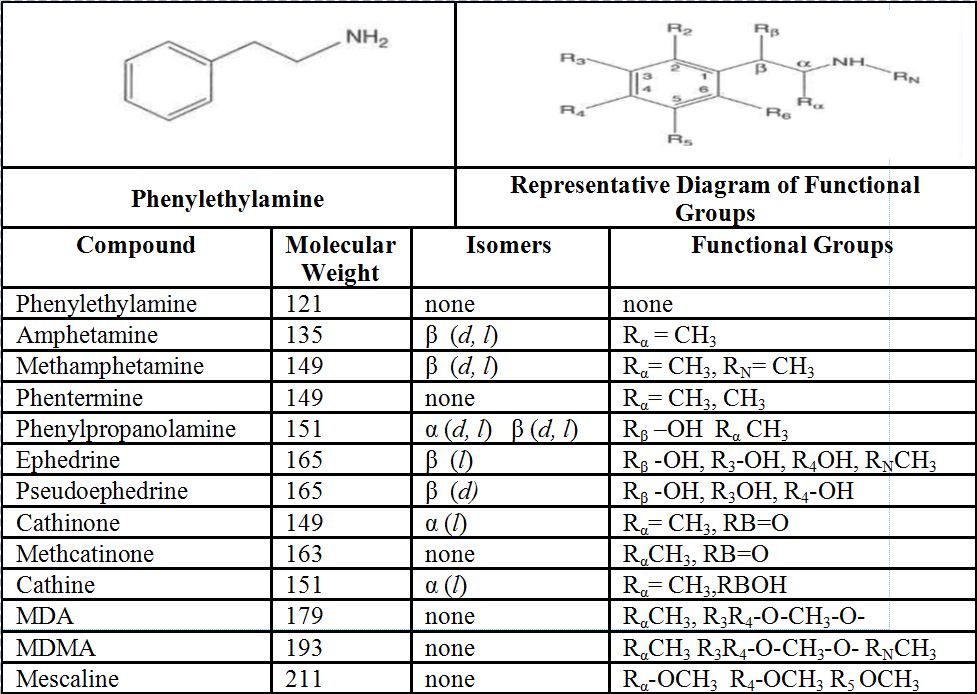Amphetamines (Part 3)
Dr. Joseph E. Graas, Scientific Director
Dr. Edward Moore, Medical Director
A urine collection is the sample of choice for the monitoring of compliance with drug treatment programs and pre employment or “for cause” monitoring programs. Saliva is a secondary choice for those cases where a urine collection can’t be obtained. The analyses of the various sample types (urine, hair sweat etc.) are all performed using very similar screening and confirmation methodologies. Amphetamines are mainly collected in urine, blood and saliva. Sweat and hair are difficult to collect and contain lower concentrations. Blood collection produces some difficulty which precludes it from routine analysis and is also used only for special cases. The following will therefore be directly applicable to all of the various samples listed above with certain adjustments in the reagents.
Specimen
We will use urine as the sample type. The collection of the urine sample is usually without problems; however there is certainly motivation for the person providing the urine to attempt to alter the sample to avoid the detection of drugs that may be present. There is a certain truism in drug testing that the only person who truly knows the drugs that may be present in the sample is the provider of that specimen. It is up to the rest of the collection and analytical personnel to have systems in place to determine the validity of the urine as a normal sample that represents the human voided physiology. These tests include creatinine and specimen validity testing and are discussed in detail in previous issues.
Immunoassay Screening
The general formulae for the entire group of antigen-antibody reactions preformed in any immunoassay drug screen are as follows:
Ag + Ag* + Ab → AgAb + Ag*Ab
The antigen (Ag) and the antigen with a label (Ag*) react with the Antibody (Ab) in a competitive fashion such that the increase in the Ag in the patient’s sample will reduce the available number of binding sites and the signal from the Ag* will be decreased. This is the quantitative basis for all of the immunoassays available (EMIT, KIMS, lateral flow, on-site, dip-sticks etc) with variations in the label or the method of separation of the labeled antigen-antibody complex (Ag*Ab) from the unlabeled complex (AgAb).
The central key component of the assay is the antibody. The production of this antibody is created by injecting an animal, either rabbit or goat, with the target molecule. For this drug class, the target molecule of methamphetamine is attached to a larger molecule (ie albumin). This albumin-methamphetamine is mixed with an immune system stimulator and then injected into the animal. The antibodies formed in the animal are extracted, separated and then formulated into the testing system’s reagent. The really significant issue regarding the antibody is that it will react with the target molecule, as well as all molecules of similar structure. This is usually noted in the cross reactivity table in the manufacturers product insert for the testing kit. As an example, if your clinic uses “on site” or “dip stick” testing products you will see this type of table on the performance guide that accompanies the kit that you purchased. To further demonstrate this problem please refer to Table 1. This is a summary of all of the compounds of interest in the phenylethylamine category. The molecule is drawn with “R” groups in various key positions. The table below will explain which “R” group is in which position for each compound. One can readily see the similarity in the structure of these compounds and that all of these molecules will react with the antibody that was generated to detect methamphetamine. The only unknown is how much cross reactivity will occur and to which molecule. An example of how to interpret a positive methamphetamine result from these testing methods can be:
- The positive is methamphetamine
- The positive is from any one or combination of the molecules in table 1.
- Biological background and interfering compounds
A confirmatory test is the only way to eliminate cross-reactivity issues and identify the target analytes or isomers.
Table Figure 1.

